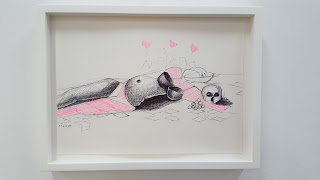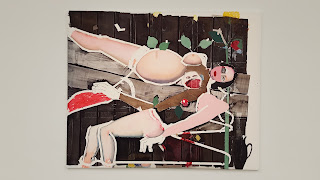Magnus Plessen was born in Hamburg in 1967 and now lives and works in Berlin. His current show, at the White Cube's Mason's Yard gallery, features paintings he's made in the last two years. They're all untitled, or at least have the title Untitled, but they're a continuation of his '1914' series of work and seek to expand and develop on the themes touched on there.
Both '1914' and this selection, subtitled 'The Skin of Volume' take as their inspiration the German pacifist Ernst Friedrich and his seminal anti-war book War Against War which was published in 1924. Even the most rudimentary scholars of history will be painfully aware that his message fell very much on deaf ears.
War Against War was the first published book to show the devastating impact of automatic weapons on the human body presenting, as it did, images of wounded and mutilated soldiers from World War I. For some reason I'd got the wrong idea about the exhibition and thought that these upsetting photographs were to be included. I'd braced myself for it but in the end I needn't have because Plessen is simply citing this as inspiration. The upstairs room sees a selection of oil paintings posted up against black walls. They feature limbs, heads, cutlery, wine bottles, food stuffs, etc; dislocated from, and disconnected to, their context. They seem to portray a disturbed mind as much as a disturbed body. They're very effective and strangely, uncomfortably, beautiful.
Multiple perspectives are employed. Plessen's images are not slaves to gravity nor are they in hock to compositional protocols. In places they're as dark as Anselm Kiefer's historical reckonings. In others as light as Sigmar Polke's gaudy semi-abstractions. Plessen is known to rotate a canvas 90 degrees during the process of making it serving, intentionally, to disrupt his relationship with the image and giving him a fresh, sometimes uneasy, perspective. He claims it gives him access to 'a layer beyond that of coherent figuration or narration without having to cut out representations altogether'. It sounds pretentious but it seems to work.
As you head downstairs, to the guts of the gallery, there's a selection of Plessen's ink on paper works to ponder. Again mutilated, smashed up bodies interact, sometimes comfortably, sometimes uncomfortably, with food. There's something sexual about them though it's a fraught, uneasy, slightly licentious sexuality.
They also remind me of the dreamlike, metaphysical paintings of Giorgio de Chirico in his pomp in that they have a yearning, unknowable quality. I'd happily have many of them on my wall where I could ponder them regularly, only slightly frustrated that they'd never reveal their sphinx like secrets.
The works in the large lower room are similar to those upstairs except instead of a black painted background they're up against white walls. It makes a difference and it does seem like Plessen, or perhaps the curators, have opted to show his fleshier works here. The introduction of a pregnant female nude in some of these works is a romantic touch. Plessen's wife was pregnant with their fourth child at the time.
There's another work in this room that seems to me to clearly reference Gustav Klimt's iconic symbolist painting The Kiss. It's rendered in Plessen's unique, and hugely recognisable, style but despite the blood, the missing body parts, and the detritus strewn across the floorboards it again aches with a wistful sense of love. Though Plessen takes inspiration from the darkest of times I get the feeling that his work speaks of coming out of the darkness into a new light. While these paintings speak of despair they also speak of hope. I was impressed. I hope Plessen's work goes on to reach much larger audiences.












No comments:
Post a Comment